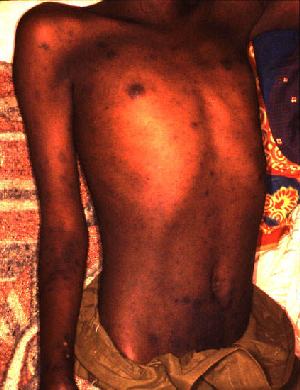
Typhoid fever, also known as typhoid, is a disease caused by Salmonella serotype Typhi bacteria. Symptoms vary from mild to severe, and usually begin six to 30 days after exposure. Often there is a gradual onset of a high fever over several days. This is commonly accompanied by weakness, abdominal pain, constipation, headaches, and mild vomiting. Some people develop a skin rash with rose colored spots. In severe cases, people may experience confusion. Without treatment, symptoms may last weeks or months. Diarrhea may be severe, but is uncommon. Other people may carry the bacterium without being affected, but they are still able to spread the disease. Typhoid fever is a type of enteric fever, along with paratyphoid fever. S. enterica Typhi is believed to infect and replicate only within humans.

Salmonella is a genus of rod-shaped (bacillus) Gram-negative bacteria of the family Enterobacteriaceae. The two known species of Salmonella are Salmonella enterica and Salmonella bongori. S. enterica is the type species and is further divided into six subspecies that include over 2,600 serotypes. Salmonella was named after Daniel Elmer Salmon (1850–1914), an American veterinary surgeon.

Psittacosis—also known as parrot fever, and ornithosis—is a zoonotic infectious disease in humans caused by a bacterium called Chlamydia psittaci and contracted from infected parrots, such as macaws, cockatiels, and budgerigars, and from pigeons, sparrows, ducks, hens, gulls and many other species of birds. The incidence of infection in canaries and finches is believed to be lower than in psittacine birds.

Salmonella enterica is a rod-headed, flagellate, facultative anaerobic, Gram-negative bacterium and a species of the genus Salmonella. A number of its serovars are serious human pathogens; many of them are serovars of Salmonella enterica subsp. enterica.

An asymptomatic carrier is a person or other organism that has become infected with a pathogen, but shows no signs or symptoms.
Hepatosplenomegaly is the simultaneous enlargement of both the liver (hepatomegaly) and the spleen (splenomegaly). Hepatosplenomegaly can occur as the result of acute viral hepatitis, infectious mononucleosis, and histoplasmosis or it can be the sign of a serious and life-threatening lysosomal storage disease. Systemic venous hypertension can also increase the risk for developing hepatosplenomegaly, which may be seen in those patients with right-sided heart failure.

Salmonellosis is a symptomatic infection caused by bacteria of the Salmonella type. It is also a food-borne disease and these are defined as diseases, usually either infectious or toxic in nature, caused by agents that enter the body through the ingestion of food. In humans, the most common symptoms are diarrhea, fever, abdominal cramps, and vomiting. Symptoms typically occur between 12 hours and 36 hours after exposure, and last from two to seven days. Occasionally more significant disease can result in dehydration. The old, young, and others with a weakened immune system are more likely to develop severe disease. Specific types of Salmonella can result in typhoid fever or paratyphoid fever.

Paratyphoid fever, also known simply as paratyphoid, is a bacterial infection caused by one of three types of Salmonella enterica. Symptoms usually begin 6–30 days after exposure and are the same as those of typhoid fever. Often, a gradual onset of a high fever occurs over several days. Weakness, loss of appetite, and headaches also commonly occur. Some people develop a skin rash with rose-colored spots. Without treatment, symptoms may last weeks or months. Other people may carry the bacteria without being affected; however, they are still able to spread the disease to others. Typhoid and paratyphoid are of similar severity. Paratyphoid and typhoid fever are types of enteric fever.
The Vi capsular polysaccharide vaccine is a typhoid vaccine recommended by the World Health Organization for the prevention of typhoid. The vaccine was first licensed in the US in 1994 and is made from the purified Vi capsular polysaccharide from the Ty2 Salmonella Typhi strain; it is a subunit vaccine.

Ty21a is a live attenuated bacterial vaccine that protects against typhoid. First licensed in Europe in 1983 and in the United States in 1989, it is an orally administered, live-attenuated Ty2 strain of S. Typhi in which multiple genes, including the genes responsible for the production of Vi, have been deleted so as to render it harmless but nevertheless immunogenic. It is one of the three typhoid vaccines currently recommended by the World Health Organization.

Typhus, also known as typhus fever, is a group of infectious diseases that include epidemic typhus, scrub typhus, and murine typhus. Common symptoms include fever, headache, and a rash. Typically these begin one to two weeks after exposure.

Salmonella enterica subsp. enterica is a subspecies of Salmonella enterica, the rod-shaped, flagellated, aerobic, Gram-negative bacterium. Many of the pathogenic serovars of the S. enterica species are in this subspecies, including that responsible for typhoid.
The 2012 outbreak of Salmonella took place in 15 places worldwide with over 2,300 strains identified.

Edward Thomas Ryan is an American microbiologist, immunologist, and physician at Harvard University and Massachusetts General Hospital. Ryan served as president of the American Society of Tropical Medicine and Hygiene from 2009 to 2010. Ryan is Professor of Immunology and Infectious Diseases at the Harvard T.H. Chan School of Public Health, Professor of Medicine at Harvard Medical School, and Director of Global Infectious Diseases at the Massachusetts General Hospital. Ryan's research and clinical focus has been on infectious diseases associated with residing in, immigrating from, or traveling through resource-limited areas. Ryan is a Fellow of the American Society of Microbiology, the American Society of Tropical Medicine and Hygiene, the American College of Physicians, and the Infectious Diseases Society of America.
Intestinal infectious diseases include a large number of infections of the bowels including: cholera, typhoid fever, paratyphoid fever, other types of salmonella infections, shigellosis, botulism, gastroenteritis, and amoebiasis among others.

The Cocoliztli Epidemic or the Great Pestilence was an outbreak of a mysterious illness characterized by high fevers and bleeding which caused 5–15 million deaths in New Spain during the 16th century. The Aztec people called it cocoliztli, Nahuatl for pestilence. It ravaged the Mexican highlands in epidemic proportions, resulting in the demographic collapse of some Indigenous populations.
The Norwegian Institute of Public Health is responsible for maintaining and revising the list of notifiable diseases in Norway and participates in the European Centre for Disease Prevention and Control (ECDC) and the World Health Organization's surveillance of infectious diseases. The notifiable diseases are classified into Group A, Group B and Group C diseases, depending on the procedure for reporting the disease.

In 2000, typhoid fever caused an estimated 21.7 million illnesses and 217,000 deaths. It occurs most often in children and young adults between 5 and 19 years old. In 2013, it resulted in about 161,000 deaths – down from 181,000 in 1990. Infants, children, and adolescents in south-central and Southeast Asia experience the greatest burden of illness. Outbreaks of typhoid fever are also frequently reported from sub-Saharan Africa and countries in Southeast Asia. In the United States, about 400 cases occur each year, and 75% of these are acquired while traveling internationally.
Melita Alison Gordon is a gastroenterologist who works on invasive gut pathogens and tropical gastrointestinal disease. She leads the Malawi Liverpool Wellcome Trust Salmonella and Enterics Group. Gordon was awarded the British Society of Gastroenterology Sir Francis Avery Jones Research Medal in 2011.

John Andrew Crump MB ChB, MD, DTM&H, FRACP, FRCPA, FRCP is a New Zealand-born infectious diseases physician, medical microbiologist, and epidemiologist. He is Professor of Medicine, Pathology, and Global Health at the University of Otago and an Adjunct Professor of Medicine, Pathology, and Global Health at Duke University. He served as inaugural Co-Director of the Otago Global Health Institute, one of the university's research centres. His primary research interest is fever in the tropics, focusing on invasive bacterial diseases and bacterial zoonoses.












